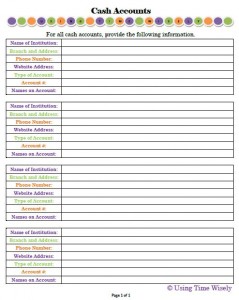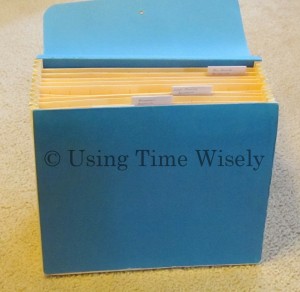 As I write this post, my desk is piled with paperwork. Though all the documents are in piles, I don’t feel organized. Sometimes I feel like the paperwork battle is a loss, but then I get everything filed and all is good again.
As I write this post, my desk is piled with paperwork. Though all the documents are in piles, I don’t feel organized. Sometimes I feel like the paperwork battle is a loss, but then I get everything filed and all is good again.
If you feel this way with your important documents, then press on in your process. My document organization journey took months to complete. Though I am currently maintaining my filing system, the process takes time and energy.
Thus far in the process, I have covered File Box 1 and File Box 2. In File Box 3, we have looked at Social Security documents and retirement plan documents. Last week, we began the investment documents with U.S. Treasury Savings Bonds. Today, we move on to cash accounts.
 Cash Accounts
Cash Accounts
In the fourth file opening of my accordion filing system, I place my cash accounts asset list. Keeping all the information in one place makes contacting the company and finding the account numbers simple.
Needing one source, I created the following free printable to record our family’s accounts. You are welcome to download and use it for your investment information as well.
Cash Accounts – pdf
Cash Accounts – WORD document
To share these resources with others, please forward the link to this post rather than sending the files directly. Thank you for protecting Using Time Wisely’s copyright.
For each account I document the following information:
Name of Institution
With multiple accounts in different financial institutions, I record all our accounts from one institution and then our accounts from another bank or credit union.
Branch and Address
Should I need to send written correspondence, I like to have the address information available without needing to look it up.
Phone Number
Any contact information, including a person’s name and extension, is helpful should an issue arise.
Website Address
Keeping this information with the other information makes checking rates, setting up bill pay, and verifying deposits a snap.
Type of Account
Noting a checking or savings or both types of accounts helps document all your accounts.
Account Numbers
This information is especially helpful for someone who may need access to your accounts should you become disabled or unavailable. If something should happen to me, Paul will have access to our information via this listing.
Names on Account(s)
All of our accounts have multiple authorizing owners and joint owners. By having joint owners, I know that someone can gain access to our funds should something happen to both Paul and I.
In documenting our cash accounts, I have the above-mentioned information recorded for each of our accounts filling up 2 sheets. These documents are placed within the fourth filing opening under the investment document category.
Weekly Project: Record all your cash accounts in one document.
As you continue organizing your important documents, gather the information for all your cash accounts including your children’s accounts. Having all of these account numbers and contact information together frees you to work on other matters. Happy organizing!
Question: Do you keep all your cash account information in one place?

